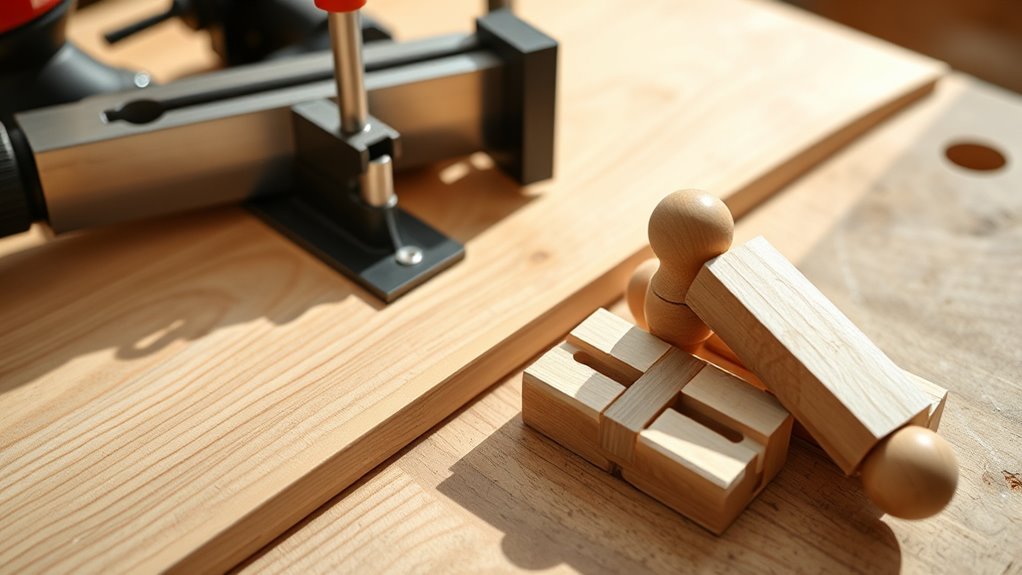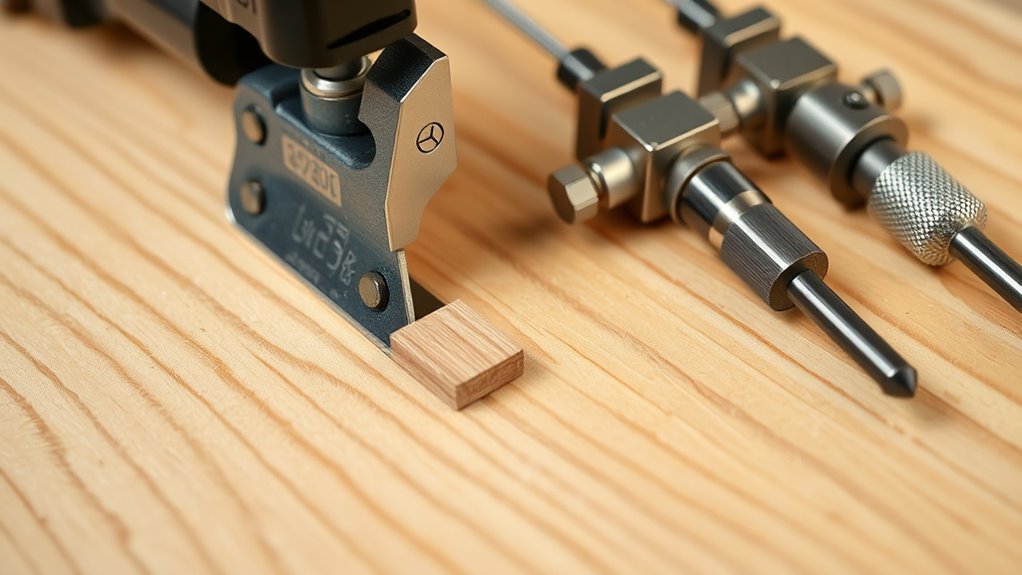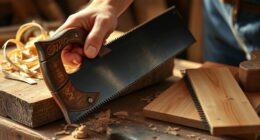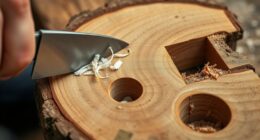Biscuit joiners, loose tenon jigs, and dowel jigs are tools that help you create strong, accurate joints in woodworking projects. They guide you in cutting precise holes or slots to fit matching components, ensuring proper alignment and stability. Using these jigs improves your joint quality and speeds up the process while maintaining safety. If you keep exploring, you’ll discover how these tools can transform your woodworking craftsmanship.
Key Takeaways
- Biscuit joiners cut slots for oval-shaped wood biscuits to align and strengthen joints seamlessly.
- Loose tenon jigs create precise mortises to insert matching tenons for durable, adjustable joints.
- Dowel jigs drill accurately aligned holes for dowels, ensuring strong and aligned wood connections.
- All three tools enhance joint strength, alignment, and appearance in woodworking projects.
- They promote safety, accuracy, and professional finishes by simplifying complex joint-making tasks.

When it comes to woodworking, achieving strong and accurate joints is vital, and biscuit joiners, loose tenon jigs, and dowel jigs are three popular tools that can help you do just that. These tools simplify the process of creating durable joints, but to get the best results, you need to pay attention to grain matching and safety precautions. Proper grain matching guarantees that the joints are not only strong but also visually seamless, minimizing any potential warping or splitting over time. When using these jigs, check the direction of the wood grain before drilling or cutting. Aligning the grain so it runs continuously across the joint helps prevent cracks and enhances stability. Additionally, make sure to select the right size of biscuits, tenons, or dowels to match the thickness and grain orientation of your workpieces. This careful matching promotes better adhesion and structural integrity, leading to a cleaner, more professional finish.
Safety precautions are paramount when working with these tools. Always wear safety glasses to protect your eyes from flying debris, especially when drilling or cutting. Keep your hands clear of the cutting path, and use clamps to stabilize your workpiece securely. Before starting, double-check that your tool is in good condition, with no loose blades or parts, and ensure you’re familiar with the manufacturer’s instructions. When using a biscuit joiner, for example, it’s essential to hold the tool firmly and maintain control to avoid kickback, which can cause injury. Similarly, when operating a loose tenon or dowel jig, be mindful of where your fingers are in relation to the drill bit or cutting surface. Using push blocks or push sticks can further reduce the risk of accidents, especially when working with larger or thicker pieces.
In addition to safety, consider working in a well-ventilated area and wearing hearing protection, as these tools can generate significant noise. Always inspect your workpieces for knots or irregular grain patterns that might weaken the joint or cause the bit to catch unexpectedly. Taking these precautions not only keeps you safe but also improves the quality of your joints. By combining mindful grain matching with diligent safety practices, you’ll produce stronger, cleaner joints and enjoy a more satisfying woodworking experience. Remember, the key to professional results lies in preparation, attention to detail, and respect for the tools you’re using.
Frequently Asked Questions
Can These Tools Be Used for Curved or Irregular Joints?
Yes, you can use these tools for curved or irregular joints, but their feasibility depends on the specific tool and your skill. Biscuit joiners, loose tenon, and dowel jigs are primarily designed for straight joints, so achieving curved or irregular joints requires special techniques or modifications. For curved joint feasibility, consider using flexible jigs or custom templates. Irregular joint techniques often involve careful marking and slow, precise adjustments for best results.
What Safety Precautions Should I Take When Using These Jigs?
When using these jigs, you should always wear safety gear like goggles and ear protection to prevent injury. Make sure to follow proper handling techniques, such as keeping your hands clear of blades and clamps, and securing your workpiece firmly. Read the manufacturer’s instructions carefully, and double-check your setup before starting. Staying attentive and cautious helps guarantee safe operation and prevents accidents during your woodworking projects.
How Do I Choose Between a Biscuit Joiner and Dowel Jig?
When choosing between a biscuit joiner and a dowel jig, consider your project needs and skill level. A joiner vs jig depends on your desired strength and alignment precision. Use tool selection tips like evaluating material thickness and joint type. If you want quick, strong joints with less alignment fuss, a biscuit joiner works well. For more control and stronger joints, especially on thicker wood, opt for a dowel jig.
Are These Tools Suitable for Fine Woodworking or Only Rough Projects?
These tools are suitable for fine woodworking because they allow you to make precision cuts and joints. They excel at creating strong, accurate connections, provided you use the right settings and technique. They’re compatible with various materials like hardwoods and softwoods, ensuring versatility. With proper handling, you can achieve professional-quality results, making them valuable even for detailed, delicate projects, not just rough construction work.
What Maintenance Is Required to Keep These Tools in Optimal Condition?
You should clean and maintain your tools regularly to keep them in top shape. About 80% of tool failures are linked to poor maintenance. Keep blades sharp through regular sharpening and make certain dust collection systems are functioning well to prevent buildup. Check moving parts for wear, lubricate where needed, and store tools properly to avoid rust and damage. Proper maintenance ensures consistent performance and extends the lifespan of your woodworking tools.
Conclusion
So, next time you pick up a biscuit joiner, loose tenon, or dowel jig, remember they all serve to strengthen your joints. Some say these tools make traditional woodworking obsolete, but that’s not entirely true—they just offer quicker, more precise options. The real secret? Combining techniques often yields the best results. Trust me, experimenting with these jigs won’t weaken your craftsmanship; it’ll elevate your projects to a whole new level.









